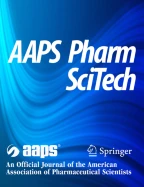Abstract
The purpose of this study was to improve the stability of cloricromene (AD6) in ophthalmic formulations and its drug availability at the ocular level. To this end, AD6-loaded polymeric nanoparticle suspensions were made using inert polymer resins (Eudragit RS100 and RL100). We modified the quasi-emulsion solvent diffusion technique by varying some formulation parameters (the drug-to-polymer ratio, the total drug and polymer amount, and the stirring speed). The chemical stability of AD6 in the nanosuspensions was assessed by preparing some formulations using (unbuffered) isotonic saline or a pH 7 phosphate buffer solution as the dispersing medium. The formulations were stored at 4°C, and the rate of degradation of AD6 was followed by high performance liquid chromatography (HPLC). The obtained nanosuspensions showed mean sizes and a positive surface charge (ζ-potential) that make them suitable for an ophthalmic application; these properties were maintained upon storage at 4°C for several months. In vitro dissolution tests confirmed a modified release of the drug from the polymer matrixes. Nanosuspensions prepared with saline solution and no or lower amounts of surfactant (Tween 80) showed an enhanced stability of the ester drug for several months, with respect to an AD6 aqueous solution. Based on the tecnological results, AD6-loaded Eudragit Retard nanoparticle suspensions appear to, offer promise as a means to improving the shelf life and bioavailability of this drug after ophthalmic application.
Similar content being viewed by others
References
Li VHK, Wood RW, Kreuter J, Harmia T, Robinson JR. Ocular drug delivery of progesterone using nanoparticles. J Microencapsul. 1986;3:213–218.
Marchal-Heussler L, Sirbat D, Hoffman M, Maincent P. Poly(ε-caprolactone) nanocapsules in carteolol ophthalmic delivery. Pharm Res. 1993;10:386–390.
Zimmer AK, Serbe H, Kreuter J. Evaluation of pilocarpine-loaded albumin particles as drug delivery systems for controlled delivery in the eye, I: in vitro and in vivo characterization. J Control Release. 1994;32:57–70.
Calvo P, Vila-Jato JL, Alonso MJ. Evaluation of cationic polymer-coated nanocapsules as ocular drug carriers. Int J Pharm. 1997;153:41–50.
Bucolo C, Maltese A, Puglisi G, Pignatello R. Enhanced ocular anti-inflammatory activity of ibuprofen carried by a Eudragit RS100® nanoparticle suspension. Ophthalmic Res. 2002; 34:319–323.
Pignatello R, Bucolo C, Spedalieri G, Maltese A, Puglisi G. Flurbiprofen-loaded acrylate polymer nanosuspensions for ophthalmic application. Biomaterials. 2002;23:3247–3255.
Pignatello R, Bucolo C, Ferrara P, Maltese A, Puleo A, Puglisi G. Eudragit RS100® nanosuspensions for the ophthalmic controlled delivery of ibuprofen. Eur J Pharm Sci. 2002;16:53–61.
Kawashima Y, Iwamoto T, Niwa T, Takeuchi H, Hino T. Size control of ibuprofen microspheres with an acrylic polymer by changing the pH in an aqueous dispersion medium and its mechanism. Chem Pharm Bull (Tokyo). 1993;41:191–195.
Perumal D, Dangor CM, Alcock RS, Hurbans N, Moopanar KR. Effect of formulation variables on in vitro drug release and micromeritic properties of modified release ibuprofen microspheres. J Microencapsul. 1999;16:475–487.
Pignatello R, Amico D, Chiechio S, Giunchedi P, Spadaro C, Puglisi G. Preparation and analgesic activity of Eudragit RS100 microparticles containing diflunisal. Drug Deliv. 2001; 8:35–45.
Squadrito F, Prosdocimi M, Altavilla D, Zingarelli B, Caputi A. Cloricromene. Cardiovasc Drug Rev. 1991;4:357–371.
Galli C, Agradi E, Petroni A, Socini A. Effects of 8-monochloro-3-beta-diethylaminoethyl-4-methyl-7-ethoxy carboxyl methoxy coumarin (AD6) on aggregation, arachidonic acid metabolism and thromboxane B2 formation in human platelets. Pharmacol Res Commun. 1980;12:329–337.
Porcellati S, Costantini V, Prosdocimi M, et al. The coumarin derivative AD6 inhibits the release of arachidonic acid by interfering phospholipase A2 activity in human platelets stimulated with thrombin. Agents Actions. 1990;29:364–373.
Travagli RA, Zatta A, Banzatto N, et al. Molecular aspects of cloricromene (AD6) distribution in human platelets and its pharmacological effects. Thromb Res. 1989;54:327–338.
Bucolo C, Cuzzocrea S, Mazzon E, Caputi AP. Effects of cloricromene, a coumarin derivative, on endotoxin-induced uveitis in Lewis rats. Invest Ophthalmol Vis Sci. 2003;44:1178–1184.
Kawashima Y, Niwa T, Handa T, Takeuchi H, Iwamoto T, Itoh K. Preparation of controlled-release micro spheres of ibuprofen with acrylic polymers by a novel quasi-emulsion solvent diffusion method. J Pharm Sci. 1989;78:68–72.
Maltese A, Bucolo C. Simultaneous determination of cloricromene and its active metabolite in rabbit aqueous humor by high-performance liquid chromatography. J Chromatogr B Analyt Technol Biomed Life Sci. 2002;767:153–158.
Benita S. Prevention of topical and ocular oxidative stress by positively charged submicron emulsion. Biomed Pharmacother. 1999;53:193–206.
Klang S, Abdulrazik M, Benita S. Influence of emulsion droplet surface charge on indomethacin ocular tissue distribution. Pharm Dev Technol. 2000;5:521–532.
Bucolo C, Maltese A, Maugeri F, Busà B, Puglisi G, Pignatello R. Eudragit RL100 nanoparticle system for the ophthalmic delivery of cloricromene. J Pharm Pharmacol. 2004;56:841–846.
Author information
Authors and Affiliations
Corresponding author
Additional information
Published: March 24, 2006
Rights and permissions
About this article
Cite this article
Pignatello, R., Ricupero, N., Bucolo, C. et al. Preparation and characterization of Eudragit Retard nanosuspensions for the ocular delivery of cloricromene. AAPS PharmSciTech 7, 27 (2006). https://doi.org/10.1208/pt070127
Received:
Accepted:
Published:
DOI: https://doi.org/10.1208/pt070127
